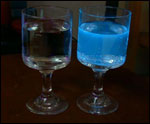 |
 |
| Tonic water (which contains quinine)
fluoresces when exposed to ultraviolet light from
a black light. |
|
Ultraviolet light is not visible to the human
eye, but we can sometimes see the effects of ultraviolet radiation.
You've probably seen black lights at your local science museum,
or even as part of a Halloween display. Black lights produce
a purple glow (visible light) but they also emit invisible
ultraviolet light. This black light can cause some materials
or substances to glow. Known as fluorescent dyes, they glow in response
to ultraviolet radiation.
In the images below you can see fluorescent
dyes glowing as they are exposed to black light. Fluorescent
dyes convert energy in the radiation into visible light. Different
fluorescent dyes produce different fluorescent colors. Unlike
normal colors, fluorescent colors absorb radiation and then
re-emit it in the visible spectrum. This makes fluorescent
colors look much brighter than normal colors.
|